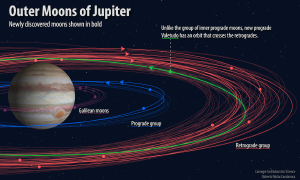Blog
And Then There
Were Seventy Nine
23 July 2018
 Roberto Molar Candanosa, Carnegie Institution for Science
Roberto Molar Candanosa, Carnegie Institution for ScienceTwelve new moons have been discovered orbiting Jupiter, bringing the grand total to seventy nine. The new moons are small, only about 1 - 3 kilometers wide, but they could provide clues to the origins of many of Jupiter’s moons.
Jupiter’s most famous moons are the four Galilean moons, that are among the largest moons in the solar system. They orbit relatively close to Jupiter, and in the same direction as Jupiter’s rotation (known as prograde rotation). A bit more distant from Jupiter is another group of prograde moons. These smaller moons have similar orbits, and were likely formed when a larger moon broke apart. Two of the newly discovered moons were found in this group.
Still more distant from Jupiter is another group of moons known as the retrograde group. These orbit in the direction opposite to Jupiter’s rotation. Nine of the new moons were discovered in this group. Because the retrograde moons are small, they likely formed much later in the history of the solar system. If they had formed in the early period when gas and dust was still largely present, drag from the gas and dust would have caused them to spiral inward toward Jupiter. So it is likely that these moons formed out of collisions between older, larger moons.
The last moon discovered is a bit odd. Given the tentative name Valetudo, it orbits in the direction of Jupiter’s rotation, but orbits at a similar distance to the retrograde group. This puts it at a high risk of colliding head on with retrograde moons. Such oddball moons don’t tend to last long on an astronomical scale. It is further evidence that collisions created these smaller moon groups.